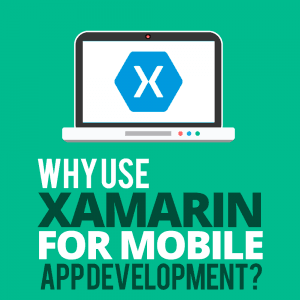Why Use Xamarin for Mobile App Development?
As mobile applications increase in popularity over websites, businesses and organizations are focusing more on developing apps. Mobile apps generally provide a better user experience (UX) than websites, as they run faster and allow the user to work offline.
However, the development of mobile apps is not an easy process and it generally takes a lot of time, especially if you are thinking of developing a cross-platform mobile app that runs on Android, Apple, and Windows simultaneously. Xamarin is among the best and most widely used platforms for the development of cross-platform apps.
In this article, we will give you a walk-through of why the Xamarin framework is the best for your mobile development needs, including the features and benefits.
What Is Cross-Platform Mobile Development?
Cross-platform mobile apps run easily on different mobile operating systems, like Android, iOS, Windows, and BlackBerry. The programmer develops one code base instead of creating new code for each individual platform.
Some benefits of cross-platform mobile app development are:
- Codes can be reused
- The development time is quicker
- It is easier to implement
- It is ideal for prototyping
In addition to Xamarin, there are many frameworks, such as Qt, PhoneGap, Ionic, and React Native, that support cross-platform development.
What Is Xamarin?
Xamarin brings .NET and C# to both Android and iOS platforms. Xamarin is amazing in the sense that it is fully .NET based and is able to produce true Android and iOS mobile apps concurrently.
Quick facts about Xamarin:
- Xamarin is one of the most cost-effective and time-efficient platforms used for building apps for different operating systems.
- Instead of designing an app for each system separately, app developers can share about 75 to 90 percent of developed code across all major mobile platforms, which decreases cost and time-to-market.
- Xamarin delivers high performance and an excellent UX.
- It ensures seamless integration and provides quality assurance and functionality testing on a wide range of devices.
These are some of Xamarin’s best features:
- Power of C# on mobile devices
- Open source
- Faster development
- Native apps with native user interface (UI) controls
- Native UI development
- Can share more than 70 to 80 percent of code across all major mobile platforms
Why Xamarin?
Xamarin is ideal for iOS and Android cross-platform development. Here are the major reasons why:
1. Code Reusability
There is a single shared C# code base in Xamarin. You don’t have to sit and write separate codes for different app platforms. You can create a single app base and use it across iOS, Android, Windows, or other platforms.
2. Native Application Programming Interface Access
Xamarin offers complete access to native application programming interfaces (APIs) on all platforms. The APIs can save developers time and effort, and help to launch quickly and successfully to the market.
3. Cost-Efficiency
Writing multiple codes at the same time for native app building in multiple platforms is not worthwhile. It draws too many hours without producing an equivalent result. However, using Xamarin, we can reduce the time and the cost. The same code base (70 to 80 percent of code) can be reused to create mobile apps that function, perform, and render native UX.
4. It’s Not Limited to Mobile App Development
Xamarin is not limited to simple mobile app development. Using Xamarin, you can develop:
- Wearable apps
- Mac apps
- TvOs apps
- OpenGL games
- SceneKit/SpriteKit/Metal games
5. It Supports Smartwatch Apps
Xamarin supports Smartwatch apps and makes it possible for you to run C# code on your wrist. Developers can use Visual Studio for Mac and Windows to build iOS Apple Watch apps, and Xamarin also supports Android Wear.
6. Simplified Maintenance
Due to its cross-platform framework for mobile apps, Xamarin makes maintenance and updates easier. You can simply deploy the changes to the source file and they will be applied to iOS, Android, and Windows apps.
7. Seamless Designs With Xamarin.Forms
The UI for apps is written in Xamarin.Forms. This helps you to create a good UX design, and can save a lot of time when preparing the UI.
Why Is It So Popular?

With the Xamarin framework, we can cover all major mobile platforms like Android, iOS, and Windows without diluting the quality and performance as a rule. Over 15,000 companies rely on Xamarin.
The Xamarin platform contains a number of elements that allow us to develop applications for iOS and Android:
- C# language — Allows a familiar syntax and sophisticated features like Generics, LINQ, and the Task Parallel Library.
- Mono .NET framework — Provides a cross-platform implementation of the extensive features in Microsoft’s .NET framework.
- Compiler — Depending on the platform, produces a native app (e.g., iOS) or an integrated .NET application and runtime (e.g., Android). The compiler also performs many optimizations for mobile deployment such as linking away unused code.
- Integrated development environment tools — The Visual Studio on Mac and Windows allows you to create, build, and deploy Xamarin projects.
Renowned companies like Cognizant, Bosch, Siemens, LEAP, 3M, Slack, and Pinterest rely on Xamarin for their mobile app development.
The Two Approaches
Xamarin has two methods for building cross-platform mobile apps:
Xamarin.Forms — You can use Xamarin.Forms when you want to design your app one time and share it across all platforms with some minor code changes.
Xamarin Native — You can use native when you want to design separate apps for each platform with the help of Xamarin.iOS, Xamarin.Android, and Xamarin.Windows libraries.
Here’s a breakdown of the difference between Xamarin.Forms and Xamarin Native:
| Xamarin.iOS, Xamarin.Android, and Xamarin.Windows | Xamarin.Forms |
| Separate UI for each platform | Single UI for all platforms |
| Supports up to 70 percent code reuse | Allows more code sharing (90 to 100 percent code reuse) |
| Development cycle is a bit slower in comparison | Development cycle is faster |
| Need to learn all-existing platforms specific to native UI views | No need to learn all-existing platforms specific to native UI views |
| Large UI and third-party components library | Small third-party components library |
| App development comparatively costs higher | App development significantly reduces overall cost |
| App performance is the best | App performance is slightly slower |
| Recommended where custom UI is more important than code sharing | Recommended where code sharing is more important than custom UI |
| Best for apps with interactions that require native behavior | Best for apps that require little platform-specific functionality |
| Stronger mechanism to clear the cache | Less mechanism to clear the cache |
| Used to create complex and advanced UI | Used for apps without many constraints on the UI |
| Supports non-portable .NET libraries | Does not support some third-party component libraries |
| Apps are better suited for large quantities of data, and it is also effective for frequent data updates | Apps are not ideal for large quantities of data, and it is not effective for frequent data updates |
| Best for apps that require specialized interactions | Best for apps that are data driven (listviews, data entry fields) |
Final Thoughts
Xamarin is an excellent, powerful platform and a leader in cross-platform mobile development at a fractional cost. You can easily build, test, and run your apps for multiple platforms with just one framework.
Xamarin has been gaining more attention during recent years, and for good reason, as it makes a significant savings in development time, maintenance, and overall client costs. Apart from these benefits, Xamarin apps also deliver a great performance and UX. This is just what we get with Xamarin.
What are your thoughts on Xamarin as a universal app development platform? Share them in the comment section.
| Published on Web Code Geeks with permission by John Sonmez, partner at our WCG program. See the original article here: Why Use Xamarin for Mobile App Development? Opinions expressed by Web Code Geeks contributors are their own. |






